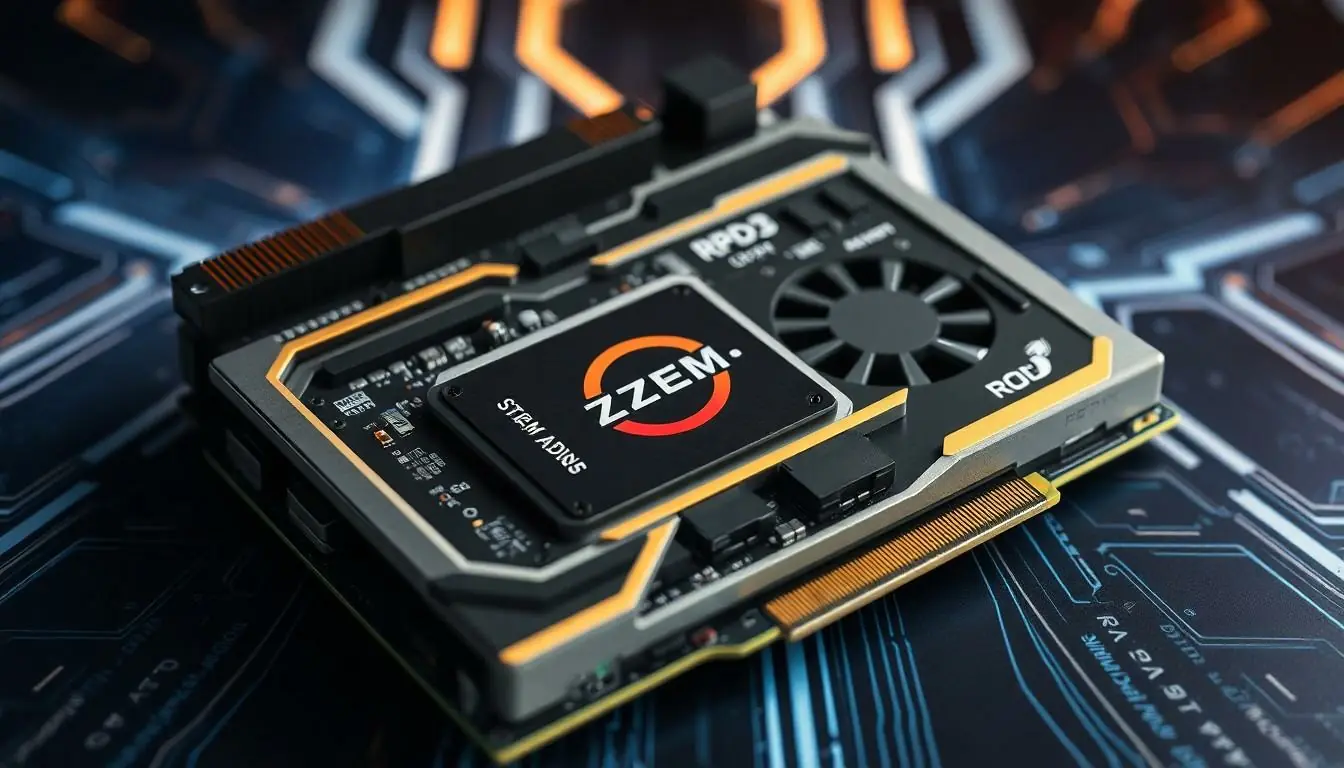Table of Contents
ToggleIn the ever-evolving world of gaming, the Steam Deck APU stands out like a unicorn at a horse race. This powerful little beast combines the magic of AMD’s latest technology with the portability of a handheld console, making it a game-changer for on-the-go gamers. Imagine diving into your favorite titles without being tethered to a desk—sounds like a dream, right?
Overview of Steam Deck APU
The Steam Deck APU combines AMD’s RDNA 2 graphics architecture with Zen 2 CPU cores. This integration allows the Steam Deck to deliver impressive performance for mobile gaming. With a total of four CPU cores and eight threads, it provides strong multitasking capabilities. Gamers experience high frame rates across a range of titles, thanks to the efficient power use of the APU.
AMD designed the APU to optimize gaming on handheld devices. It runs at a thermal design power of 15 watts, balancing performance and battery life effectively. The GPU clock speed can reach up to 1.6 GHz, enabling the Steam Deck to handle demanding games. Additionally, the APU supports DirectX 12 and Vulkan APIs, enhancing compatibility with various game engines.
Developers benefit from tools offered by AMD, which maximize the APU’s capabilities. Shedding light on its custom architecture, the APU includes support for features like variable rate shading and ray tracing. Such features boost visual fidelity, providing a richer gaming experience.
Efficient memory access plays a crucial role in the APU’s performance. The Steam Deck uses LPDDR5 RAM, operating at 5500 MT/s, offering increased bandwidth compared to previous generations. This fast memory enables smoother gameplay and quicker load times.
Lastly, the integrated nature of the Steam Deck APU means compact design and cost efficiency for the device. This advancement in technology meets the demands of modern gaming, making the Steam Deck a compelling option for gamers looking for portability and power.
Architecture of Steam Deck APU
The Steam Deck APU showcases advanced architecture that combines efficiency and performance. It integrates both CPU and GPU components for an optimal gaming experience.
CPU Specifications
The CPU employs AMD’s Zen 2 architecture, featuring four cores and eight threads. This setup allows the Steam Deck to handle multitasking without difficulty. Clock speeds reach up to 3.5 GHz, providing ample processing power for demanding games. Support for simultaneous multithreading enhances performance during resource-intensive tasks. This architecture ensures the device can efficiently run modern game titles while maintaining stable performance.
GPU Specifications
Graphics performance stems from AMD’s RDNA 2 architecture. The GPU operates with up to 1.6 GHz clock speed, delivering a potent visual experience. It includes 8 compute units which facilitate advanced graphics rendering and enhance visual fidelity. The APU supports advanced features like ray tracing and variable rate shading, improving realism in games. DirectX 12 and Vulkan API compatibility allows developers to fully utilize the GPU’s capabilities, further elevating the gaming experience.
Performance Analysis
The Steam Deck APU delivers remarkable performance across gaming and efficiency metrics. Its cutting-edge architecture positions it as a powerhouse in the handheld gaming market.
Gaming Performance
Gaming on the Steam Deck APU showcases impressive capabilities. Players can enjoy modern titles without sacrificing quality. Four CPU cores, eight threads, and RDNA 2 graphics create an engaging environment with smooth frame rates. Performance with demanding games remains consistent, especially at GPU clock speeds of up to 1.6 GHz. Features like ray tracing and variable rate shading enhance visual fidelity. Gamers benefit from support for both DirectX 12 and Vulkan APIs, ensuring compatibility with various game engines. The compact design does not compromise graphics quality, giving players freedom to enjoy a diverse library of games.
Power Efficiency
Power efficiency stands out in the Steam Deck APU’s design. It operates at a thermal design power of 15 watts, striking a balance between performance and battery life. Efficient LPDDR5 RAM at 5500 MT/s reduces load times, contributing to a seamless gaming experience. Low power consumption allows extended play sessions without frequent charging, enhancing portability. Moreover, the integration of CPU and GPU components minimizes energy waste while maximizing output. This careful engineering ensures that gamers have access to high performance without draining the battery quickly.
Comparison with Competitors
The Steam Deck APU stands out in the crowded handheld gaming market. Its integration of AMD technology provides a unique blend of performance and portability compared to competitors.
Similar Devices
Similar devices include the Asus ROG Ally and the GPD Win 3. Both utilize AMD and Intel chips, respectively, but don’t quite match the Steam Deck’s power efficiency. The Asus ROG Ally leverages AMD’s latest architecture but lacks the seamless performance the Steam Deck delivers. GPD Win 3 offers portability but falls short in terms of graphics capabilities and battery life. Handheld consoles generally face challenges with performance versus portability, making the Steam Deck a compelling option for gamers.
Performance Metrics
Steam Deck APU features impressive performance metrics. With four CPU cores and eight threads, it handles multitasking efficiently. Operating at a thermal design power of 15 watts, it balances performance and battery endurance. Benchmark tests reveal that it outperforms comparable handheld devices in graphic-intensive scenarios. GPU clock speeds reaching up to 1.6 GHz support demanding titles without a hitch. Overall, these specifications position the Steam Deck APU as a leader among similar products, delivering an optimal gaming experience.
Future Implications
The Steam Deck APU significantly shapes the future of handheld gaming technology. Its efficient architecture, which combines AMD’s RDNA 2 graphics with Zen 2 CPU cores, sets new standards for mobile gaming performance. Gamers can expect continued advancements in game quality, thanks to the support for DirectX 12 and Vulkan APIs. Additionally, features like ray tracing and variable rate shading enhance visual experiences, pushing the boundaries of what portable devices can achieve.
A focus on power efficiency allows for extended gaming sessions. With a thermal design power of just 15 watts, the APU promotes longer play without frequent recharges, attracting more users to handheld consoles. This efficiency could influence competition, prompting other manufacturers to prioritize similar architectures in their designs.
Optimizing the balance between performance and battery life creates possible avenues for further innovation. As developers explore the integration of more powerful GPUs and CPUs, new gaming experiences may emerge. With the Steam Deck APU already showcasing remarkable multitasking capabilities, it provides a framework for future handheld consoles aiming for similar or superior performance levels.
Examining the broader gaming landscape reveals implications for cross-platform play. As portable devices like the Steam Deck enhance gaming experiences, players may expect better compatibility between platforms. Emphasizing seamless gaming experiences can push software developers to revisit optimization techniques, ensuring titles run smoothly across devices.
Integration of advanced technologies continues to impact gamer expectations. Their desire for high performance in compact devices means future designs must align with this vision. Monitoring the success of the Steam Deck APU and its competitors will inform industry trends, guiding future innovations in portable gaming solutions.
Conclusion
The Steam Deck APU stands out as a game-changer in the handheld gaming landscape. With its blend of powerful CPU and GPU capabilities it redefines what gamers can expect from portable devices. Its efficient architecture not only enhances performance but also ensures longer play sessions without constant recharging.
As the gaming industry continues to evolve the Steam Deck APU sets a high bar for future handheld consoles. By prioritizing both power and efficiency it paves the way for innovative gaming experiences. Gamers can look forward to a future where high-quality titles are accessible on the go without compromising on performance or visual fidelity.





